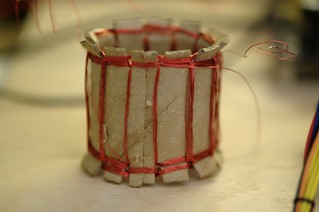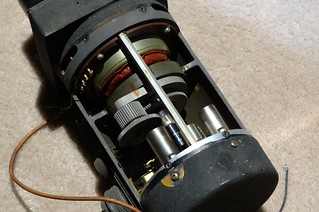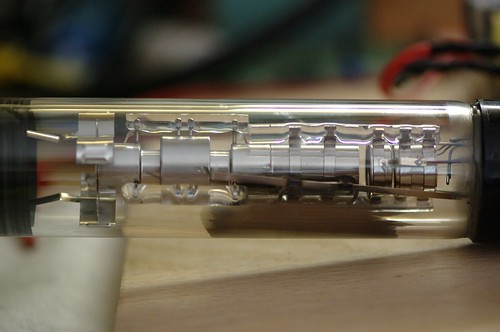CRTs with Magnetic Deflection
May 26, 2014 2:21 pm Projects, UncategorizedWhew, Maker Faire was a lot of work, and a lot of fun!
Now that the Asteroids arcade machines are finished, I’m thinking about some suggestions that people gave me. A lot of people want a larger screen. Even with a precision 3″ CRT (3RP1A, for the curious), playing the game involves lots of squinting and hunching over.
In my collection I have a pile of 5″ CRTs, mostly electrostatic but a few magnetic. The electrostatic CRTs are quite long: 16 3/4″ is a pretty common length but some are even longer. The distance is necessary to maintain a reasonable deflection factor. 70-100 volts applied across a pair of deflection plates leads to 1″ of beam deflection. While I could certainly build a project with a very long case, this gives me a good excuse to experiment with a few of the magnetic CRTs I have.
Starting with cardboard harvested from old toilet paper rolls, I made a tube that can slip over the neck of a CRT. Next I cut 12 notches in both ends so I could hook magnet wire around them. Then I cut the whole arrangement into two halves to make it easier to wind the first set of coils on the inside of the tube.

Then I wound 19 turns of wire on each half, starting with a small set of 3 turns spanning 2 notches, and then winding 7 turns across 3 notches, and finally 9 turns across 5 notches. After taping the two halves back together, I soldered the two sets of windings together in series. The polarity is critical because the magnetic fields need to add together, not cancel out. The second set of windings used the same winding pattern only this time I wound them on the outside of the cardboard tube and rotated 90 degrees.
This coil arrangement is called a semidistributed winding: look at (c) in the figure below.

After wrapping a layer of insulating tape over the windings, I wound a thin strip of soft steel around the whole thing. This provides a high permeability path for the part of the magnetic field outside of the CRT envelope. The idea behind the winding technique and all that is to create a uniform magnetic field in the path of the electron beam. The uniform magnetic field deflects the electron beam according to the Lorentz force law:
F=q(E + v x B)
E is the electric field. In this case, it’s the potential between the cathode and the anodes in the electron gun as well as the final anode. This accelerates the electrons forward towards the face of the CRT. The deflection force is the cross product of the velocity (v) and the magnetic (B) field. You can figure out the direction of force using the left hand rule. Since the electrons are moving towards the screen, a magnetic field in the up-and-down direction pushes the electron beam from side to side. This means that the horizontal deflection coils have to be positioned on the top and bottom of the CRT neck.

And it worked! I slid the yoke onto the neck of a 5AXP4 which is a CRT designed for electrostatic focus and magnetic deflection. It took nearly 1 amp to get a bit under an inch of deflection. To decrease the current I can add more windings. There’s a classic engineering tradeoff there between response speed (bandwidth) and current, since more turns have more inductance and parasitic capacitance. Incidentally, since the magnetic field strength is proportional to the current in the coils, I’ll have to drive them with a linear amplifier design that servos the current instead of the voltage.
The next step is to figure out how to handle magnetic focus. I have a 5FP14 which requires an external permanent magnet or electromagnet to focus the beam instead of the usual electrostatic lens. My friend Kent sold me a military radar display that uses a 5FP7A, and this display has a ring magnet connected with a screw and gear mechanism to adjust the focus.

A great resource for me has been the MIT Radiation Laboratory Series, Volume 22: Cathode Ray Displays, available here as a free PDF download. It’s full of details on how deflection and focus coils were manufactured.
I’ll leave you with this beautiful shot of the zero-first-anode-current electron gun assembly in the 5AXP4. The visible elements are (right to left): cathode, grid, accelerator, focus electrode, and second anode (electrically tied to the accelerator).


Vaughn :
Date: August 3, 2015 @ 1:00 pm
using your Magamp and 3 attempts of your yoke, I only got poor results with a maximum scan size of 3 inches. I wish you would release more details about your yoke design.
eric :
Date: August 4, 2015 @ 4:32 pm
Vaughn, the PDF document I link in the post (https://www.jlab.org/ir/MITSeries.html, see volume 22) has lots of detail on yoke winding. If you want to increase your scan size, you can increase the number of turns (at the expense of bandwidth). R14 and R25 set the current gain; you could reduce the values to 0.1 ohm to increase the current in the windings, but you’ll find that the LM4765 will get quite hot.
edward :
Date: August 3, 2019 @ 1:58 am
hi eric!
the link to the document al jlag..org is not working?
i get You don’t have permission to access /ir/MITSeries/V22.PDF on this server for response!
(sorry my ugly english)
eric :
Date: October 29, 2019 @ 9:50 pm
Uh oh, they must have taken it down. 🙁
Hopper :
Date: December 16, 2019 @ 5:50 pm
Hey Guys,
I fount the PDFs here.
https://www.febo.com/pages/docs/RadLab/
scott :
Date: January 10, 2020 @ 7:35 pm
The book is available on the internet archive,
https://archive.org/details/MITRadiationLaboratorySeries22CathodeRayTubesDisplays
Clay :
Date: April 29, 2020 @ 3:53 am
Found an archived copy of the V22.PDF doc online for those of you still looking– http://www.bunkerofdoom.com/lit/CRT-scopes/resource/V22.pdf